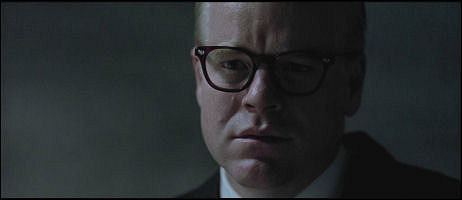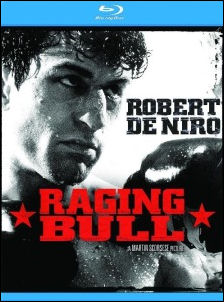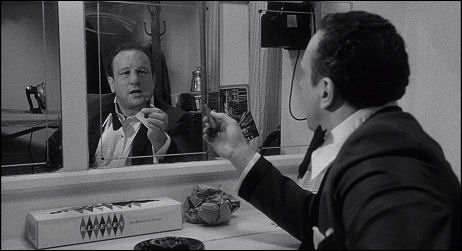The mystifying if not ridiculous success of Michael Bay and Marcus Nispel‘s Friday the 13th — $20 million yesterday, estimated to bring in over $50 million over the four-day President’s Day holiday — at least underlines the old truism about the movie business being recession- or depression-proof. Or that it tends to be, certainly, when there’s something playing that people unencumbered by taste are looking to see. A good thing, that. The sexual metaphor of slasher movies translates so fully. The dumbest people in the world get it, and that’s fine because every so often they need to feel they’re in on the joke.
Day: February 14, 2009
Capote Pair
Thematically-linked Blu-ray double features…sure. Although I’m wondering if I can stand to watch In Cold Blood again. Everyone has limits and there’s something awfully tedious and on-the-nose about it. Maybe it’s the way the Quincy Jones score sometimes tries to underscore the sentiment in a scene when it’s already dead obvious what you’re supposed to be feeling. (I hate scores that do that.) Maybe it’s Scott Wilson‘s performance, which seems too soft and charming given the notorious psychopath he’s supposed to be playing (i.e., Dick Hickock). It’s just that Conrad Hall‘s black-and-white widescreen cinematography is so choice.

From Bernnet Miller’s Capote

Robert Blake in Richard Brooks’ In Cold Blood.
Won’t Fit The Mold
“I think we can safely say that a woman like Gwyneth Paltrow has never in the history of NYC fallen in love with a 30-something” — a downbeat donkey, played by Joaquin Phoenix — “who lives with his parents in Brighton Beach.” So said Ben, a N.Y. Times commenter, early this morning about James Gray‘s Two Lovers. “Which pretty much ruins the movie as a serious work before you even see it, since it’s constantly reminding you of its inauthenticity.”
Add this gripe to my own about Vinessa Shaw being poorly cast as a slightly-too-nice Brooklyn neighborhood girl, and you’ve got both female leads in this film drawing flak.
Shaw is “too Fairfield County pretty, too poised and delicate to be a borough girl,” I wrote. “There are exceptions galore in real life, of course, but men and women from Brooklyn and Queens (i.e., those born and raised) tend to exude a slight coarseness. A coarseness that’s often vibrant and agreeable (I know New Yorkers and it’s not a cliche), but is also saddled, I feel, with a lack of curiosity in other realms.
“A wanting for worldly finesse, I mean. An Adrianna-from-The Sopranos quality. Not to mention that happily hunkered- down attitude about being ‘borough’ — a life of eating pizza, not quite dressing the right way and failing to learn to speak French or play piano. Not to mention the distinctive ethnic features and honky accents. (I’ve known exactly one woman in my life who was raised in Brooklyn but doesn’t look it or talk it.)”
Moore vs. Wall Street
That untitled Michael Moore documentary mentioned as a possible Cannes 2009 entry by Screen International‘s Mike Goodridge is either (a) some phantom doc no one’s ever heard of or (b) Moore’s currently shooting film about Wall Street chicanery which he’s said will be about “the biggest swindle in American history” as well as “the greatest crime story ever told.”
If it’s the latter it seems unlikely that Moore would have anything to show three months from now since he’s still looking for Wall Street veterans to come forward and spill the beans. That means he’s in the earlyish stages. If anything, I’m guessing that Moore will have, at best, a 15 minute reel to show next May, something to drum up interest for next year.
“I am in the middle of shooting my next movie and I am looking for a few brave people who work on Wall Street or in the financial industry to come forward and share with me what they know,” Moore posted last Wednesday on his site.
“Based on those who have already contacted me, I believe there are a number of you who know ‘the real deal’ about the abuses that have been happening. You have information that the American people need to hear. I am humbly asking you for a moment of courage, to be a hero and help me expose the biggest swindle in American history.
“All correspondence with me will be kept confidential. Your identity will be protected and you will decide to what extent you wish to participate in telling the greatest crime story ever told.”
Blu-ray Grain, Speckles
The just-out Raging Bull Bluray “produces a more subtle visual improvement than many are used to seeing in high-definition,” writes DVD Beaver’s Henrik Sylow. “The contrast is superior” but “much more of the intended grain is [also] noticeable.” I remember the raw deglammed look and murky sound of Raging Bull when I first saw it at Manhattan’s Beekman theatre in 1980, so I know what the idea was back then and what this new Bluray is trying to recapture.

An avoidance of “pretty” was key. Scorsese wanted a flat visual representation of the primitive life of the LaMottas of the Bronx and Pelham Parkway, and no allowances whatsoever for sexy, satiny monochrome. I got it and the Beekman certainly projected that, but I was also gratified, frankly, when Raging Bull was cleaned up and enhanced on DVD three and a half years ago.
I’m not sure I want a Bluray that’s going to take me back to the Beekman. Who wants to shell out for a Raging Bull that provides a preponderance of grain and speckles? I’ll tell you who. The monks do. The Glenn Kenny/Dave Kehr crowd.
I was quite happy with the ’05 Raging Bull special edition DVD because it made the film look sharper and more silvery than ever before without sacrificing, obviously, the essential New York cruddiness of the thing. The textural pleasures of Raging Bull were captured by Michael Chapman‘s photography and Phil Abramson and Frederic C. Weiler‘s sets, and not by the diminished projection standards that existed 28 or 29 years ago.
The ’05 DVD also allowed me to hear Raging Bull much more clearly. Some of Joe Pesci‘s quiet dialogue scenes in the print that I saw projected at the Beekman (or at the Sutton on 57th Street) were so faint I was cupping my ears half the time.

The sound is presumably first-rate on the Blu-ray Bull but the visual trend among the high-end Blu-ray aesthetes, apparently, is to rough up the transfer and bring out the grain and speckles and whatnot — to avoid creating some arid digital upgrade in favor of a recreation of a somewhat worn celluloid print showing in the early days of the Reagan administration.
“The biggest differences,” Syklow says, “are the contrast and grain while I was a bit surprised at the amount of speckles.” And yet, he says, the Blu-ray is “far and away the most film-like image and faithful to theatrical of all editions.” The question is what does he really mean by “film-like”? Neighborhood theatre film-like (i.e., vaguely shitty) or Columbia screening-room quality (i.e., as good as it gets). I get a little bit scared when I hear grain-purist types say this. Because they live on a different planet.
